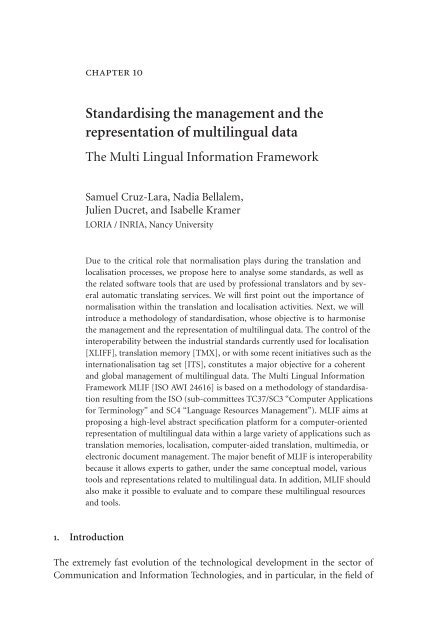Topics in Language Resources for Translation ... - ymerleksi - home
Topics in Language Resources for Translation ... - ymerleksi - home
Topics in Language Resources for Translation ... - ymerleksi - home
- No tags were found...
Create successful ePaper yourself
Turn your PDF publications into a flip-book with our unique Google optimized e-Paper software.
chapter 10Standardis<strong>in</strong>g the management and therepresentation of multil<strong>in</strong>gual dataThe Multi L<strong>in</strong>gual In<strong>for</strong>mation FrameworkSamuel Cruz-Lara, Nadia Bellalem,Julien Ducret, and Isabelle KramerLORIA / INRIA, Nancy UniversityDue to the critical role that normalisation plays dur<strong>in</strong>g the translation andlocalisation processes, we propose here to analyse some standards, as well asthe related software tools that are used by professional translators and by severalautomatic translat<strong>in</strong>g services. We will first po<strong>in</strong>t out the importance ofnormalisation with<strong>in</strong> the translation and localisation activities. Next, we will<strong>in</strong>troduce a methodology of standardisation, whose objective is to harmonisethe management and the representation of multil<strong>in</strong>gual data. The control of the<strong>in</strong>teroperability between the <strong>in</strong>dustrial standards currently used <strong>for</strong> localisation[XLIFF], translation memory [TMX], or with some recent <strong>in</strong>itiatives such as the<strong>in</strong>ternationalisation tag set [ITS], constitutes a major objective <strong>for</strong> a coherentand global management of multil<strong>in</strong>gual data. The Multi L<strong>in</strong>gual In<strong>for</strong>mationFramework MLIF [ISO AWI 24616] is based on a methodology of standardisationresult<strong>in</strong>g from the ISO (sub-committees TC37/SC3 “Computer Applications<strong>for</strong> Term<strong>in</strong>ology” and SC4 “<strong>Language</strong> <strong>Resources</strong> Management”). MLIF aims atpropos<strong>in</strong>g a high-level abstract specification plat<strong>for</strong>m <strong>for</strong> a computer-orientedrepresentation of multil<strong>in</strong>gual data with<strong>in</strong> a large variety of applications such astranslation memories, localisation, computer-aided translation, multimedia, orelectronic document management. The major benefit of MLIF is <strong>in</strong>teroperabilitybecause it allows experts to gather, under the same conceptual model, varioustools and representations related to multil<strong>in</strong>gual data. In addition, MLIF shouldalso make it possible to evaluate and to compare these multil<strong>in</strong>gual resourcesand tools.1. IntroductionThe extremely fast evolution of the technological development <strong>in</strong> the sector ofCommunication and In<strong>for</strong>mation Technologies, and <strong>in</strong> particular, <strong>in</strong> the field of
















